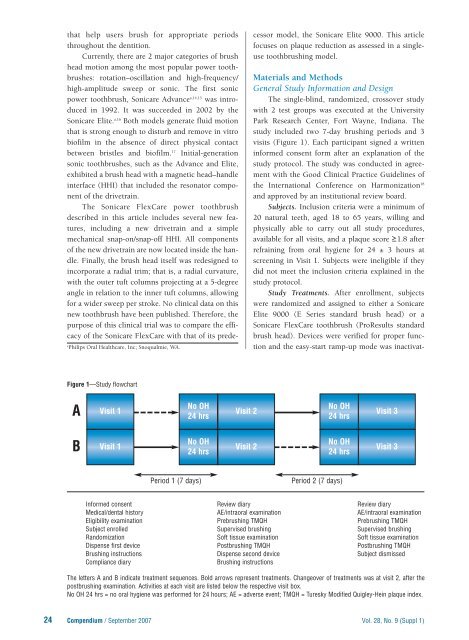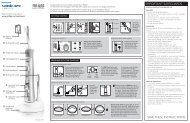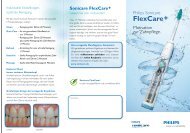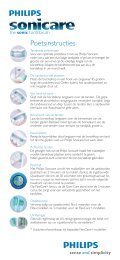Philips Sonicare FlexCare - Sonicare.com - Sonicare
Philips Sonicare FlexCare - Sonicare.com - Sonicare
Philips Sonicare FlexCare - Sonicare.com - Sonicare
Create successful ePaper yourself
Turn your PDF publications into a flip-book with our unique Google optimized e-Paper software.
a<br />
<strong>Philips</strong> Oral Healthcare, Inc; Snoqualmie, WA.<br />
that help users brush for appropriate periods<br />
throughout the dentition.<br />
Currently, there are 2 major categories of brush<br />
head motion among the most popular power toothbrushes:<br />
rotation–oscillation and high-frequency/<br />
high-amplitude sweep or sonic. The first sonic<br />
power toothbrush, <strong>Sonicare</strong> Advance a,14,15 was introduced<br />
in 1992. It was succeeded in 2002 by the<br />
<strong>Sonicare</strong> Elite. a,16 Both models generate fluid motion<br />
that is strong enough to disturb and remove in vitro<br />
biofilm in the absence of direct physical contact<br />
between bristles and biofilm. 17 Initial-generation<br />
sonic toothbrushes, such as the Advance and Elite,<br />
exhibited a brush head with a magnetic head–handle<br />
interface (HHI) that included the resonator <strong>com</strong>ponent<br />
of the drivetrain.<br />
The <strong>Sonicare</strong> <strong>FlexCare</strong> power toothbrush<br />
described in this article includes several new features,<br />
including a new drivetrain and a simple<br />
mechanical snap-on/snap-off HHI. All <strong>com</strong>ponents<br />
of the new drivetrain are now located inside the handle.<br />
Finally, the brush head itself was redesigned to<br />
incorporate a radial trim; that is, a radial curvature,<br />
with the outer tuft columns projecting at a 5-degree<br />
angle in relation to the inner tuft columns, allowing<br />
for a wider sweep per stroke. No clinical data on this<br />
new toothbrush have been published. Therefore, the<br />
purpose of this clinical trial was to <strong>com</strong>pare the efficacy<br />
of the <strong>Sonicare</strong> <strong>FlexCare</strong> with that of its predecessor<br />
model, the <strong>Sonicare</strong> Elite 9000. This article<br />
focuses on plaque reduction as assessed in a singleuse<br />
toothbrushing model.<br />
Materials and Methods<br />
General Study Information and Design<br />
The single-blind, randomized, crossover study<br />
with 2 test groups was executed at the University<br />
Park Research Center, Fort Wayne, Indiana. The<br />
study included two 7-day brushing periods and 3<br />
visits (Figure 1). Each participant signed a written<br />
informed consent form after an explanation of the<br />
study protocol. The study was conducted in agreement<br />
with the Good Clinical Practice Guidelines of<br />
the International Conference on Harmonization 18<br />
and approved by an institutional review board.<br />
Subjects. Inclusion criteria were a minimum of<br />
20 natural teeth, aged 18 to 65 years, willing and<br />
physically able to carry out all study procedures,<br />
available for all visits, and a plaque score ≥1.8 after<br />
refraining from oral hygiene for 24 ± 3 hours at<br />
screening in Visit 1. Subjects were ineligible if they<br />
did not meet the inclusion criteria explained in the<br />
study protocol.<br />
Study Treatments. After enrollment, subjects<br />
were randomized and assigned to either a <strong>Sonicare</strong><br />
Elite 9000 (E Series standard brush head) or a<br />
<strong>Sonicare</strong> <strong>FlexCare</strong> toothbrush (ProResults standard<br />
brush head). Devices were verified for proper function<br />
and the easy-start ramp-up mode was inactivat-<br />
Figure 1—Study flowchart<br />
A<br />
Visit 1<br />
No OH<br />
24 hrs<br />
Visit 2<br />
No OH<br />
24 hrs<br />
Visit 3<br />
B Visit 1<br />
No OH<br />
24 hrs<br />
Visit 2<br />
No OH<br />
24 hrs<br />
Visit 3<br />
Period 1 (7 days)<br />
Period 2 (7 days)<br />
Informed consent Review diary Review diary<br />
Medical/dental history AE/intraoral examination AE/intraoral examination<br />
Eligibility examination Prebrushing TMQH Prebrushing TMQH<br />
Subject enrolled Supervised brushing Supervised brushing<br />
Randomization Soft tissue examination Soft tissue examination<br />
Dispense first device Postbrushing TMQH Postbrushing TMQH<br />
Brushing instructions Dispense second device Subject dismissed<br />
Compliance diary<br />
Brushing instructions<br />
The letters A and B indicate treatment sequences. Bold arrows represent treatments. Changeover of treatments was at visit 2, after the<br />
postbrushing examination. Activities at each visit are listed below the respective visit box.<br />
No OH 24 hrs = no oral hygiene was performed for 24 hours; AE = adverse event; TMQH = Turesky Modified Quigley-Hein plaque index.<br />
24 Compendium / September 2007 Vol. 28, No. 9 (Suppl 1)










